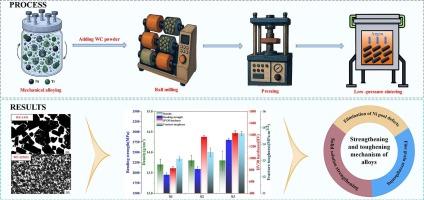利用NiTi固溶体粘结剂增强WC-15NiTi合金力学性能:硬质合金领域的突破
IF 4.6
2区 材料科学
Q2 MATERIALS SCIENCE, MULTIDISCIPLINARY
International Journal of Refractory Metals & Hard Materials
Pub Date : 2025-08-22
DOI:10.1016/j.ijrmhm.2025.107396
引用次数: 0
摘要
为克服常规WC-Ni合金力学性能差的技术局限,以NiTi固溶体粉末为粘结相前驱体制备了具有优异力学性能的WC-15NiTi合金。本研究旨在探讨引入Ti的不同方法如何影响所得合金的显微组织演变和力学行为。实验结果表明,加入NiTi固溶体粉末可以有效抑制WC晶粒的异常生长,显著减小平均晶粒尺寸,促进结合相均匀分散,同时避免Ni池缺陷的形成。与无ti合金相比,合金的抗弯强度为2804 MPa,维氏硬度为1427 HV30,断裂韧性为14.65 MPa·m1/2,分别提高了43.5%、72.7%和12%。此外,在烧结过程中,NiTi固溶体主要保留在合金的微观组织中。这有助于通过固溶硬化和改善与WC颗粒的界面附着力等机制增强材料的结构特征和机械性能。该研究对WC-Ni复合材料中固溶体结合相的增强性和抗断裂性进行了有价值的研究,为推进其他高强度金属陶瓷的设计和制造提供了潜在的策略。本文章由计算机程序翻译,如有差异,请以英文原文为准。

Enhanced mechanical properties of WC-15NiTi alloy via NiTi solid solution binder: A breakthrough in cemented carbides
To overcome the technical limitation of inferior mechanical performance in conventional WC-Ni alloys, a WC-15NiTi alloy exhibiting superior mechanical characteristics was fabricated by employing NiTi solid solution powders as the binder-phase precursor. This research aims to explore how different approaches of introducing Ti affect the microstructural evolution and mechanical behavior of the resulting alloy. Experimental findings indicate that incorporating NiTi solid solution powders can efficiently suppress the abnormal growth of WC grains, markedly reduce the average grain size, and promote a homogeneous dispersion of the bonding phase while avoiding the formation of Ni pool defects. These improvements yield a bending strength of 2804 MPa, a Vickers hardness of 1427 HV30, and a fracture toughness of 14.65 MPa·m1/2, representing increases of 43.5 %, 72.7 % and 12 %, respectively, relative to the Ti-free alloy. Furthermore, the NiTi solid solution phase is predominantly retained within the alloy's microstructure following the sintering process. This contributes to the enhancement of both the structural characteristics and mechanical performance of the material through mechanisms such as solid solution hardening and improved interfacial adhesion with WC particles. The study presents a valuable investigation into the reinforcement and fracture resistance imparted by the solid solution binder phase in WC-Ni composites, shedding light on potential strategies for advancing the design and fabrication of other high-strength metallic ceramics.
求助全文
通过发布文献求助,成功后即可免费获取论文全文。
去求助
来源期刊
CiteScore
7.00
自引率
13.90%
发文量
236
审稿时长
35 days
期刊介绍:
The International Journal of Refractory Metals and Hard Materials (IJRMHM) publishes original research articles concerned with all aspects of refractory metals and hard materials. Refractory metals are defined as metals with melting points higher than 1800 °C. These are tungsten, molybdenum, chromium, tantalum, niobium, hafnium, and rhenium, as well as many compounds and alloys based thereupon. Hard materials that are included in the scope of this journal are defined as materials with hardness values higher than 1000 kg/mm2, primarily intended for applications as manufacturing tools or wear resistant components in mechanical systems. Thus they encompass carbides, nitrides and borides of metals, and related compounds. A special focus of this journal is put on the family of hardmetals, which is also known as cemented tungsten carbide, and cermets which are based on titanium carbide and carbonitrides with or without a metal binder. Ceramics and superhard materials including diamond and cubic boron nitride may also be accepted provided the subject material is presented as hard materials as defined above.

 求助内容:
求助内容: 应助结果提醒方式:
应助结果提醒方式:


